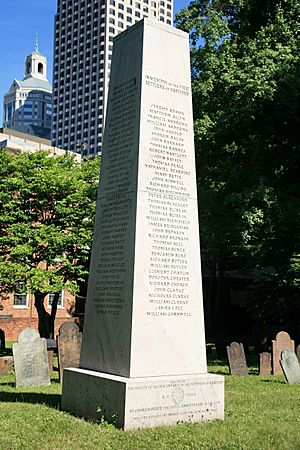Thomas Bull facts for kids
Quick facts for kids
Captain
Thomas Bull
|
|
|---|---|
| Born | c. 1605 Great Britain
|
| Died | October 12, 1684 Hartford, CT
|
| Nationality | |
| Occupation | Army Officer Merchant |
| Spouse(s) | Susannah Bull |
| Children | Thomas Bull David Bull Ruth Bull Boardman Jonathan Bull Abigail Bull Joseph Bull Susannah Bull Bunce |
Thomas Bull (born around 1605, died October 12, 1684) was an important early settler in the Connecticut Colony. He is known as one of the people who helped start the city of Hartford, Connecticut. He was also called Captain Thomas Bull.
Thomas Bull and the Pequot War
Thomas Bull came to Hartford in 1636. He traveled with a famous leader named Thomas Hooker. In 1637, Bull fought in the Pequot War. This was a conflict between English colonists and the Pequot Native American tribe.
During the war, Lieutenant Bull showed great bravery. He helped rescue a wounded soldier named Arthur Smith from Mistick Fort. In one battle, an arrow hit Bull. Luckily, it struck a hard piece of cheese in his pocket, saving him from serious injury! This story shows how even a small bit of protection can help a lot.
Because of his service in the Pequot War, Thomas Bull received a large piece of land. This land was near the Niantic River. Today, this area is the town of East Lyme, Connecticut.
Connecticut-New York Border Dispute
In 1675, Captain Bull was in charge of the Connecticut Colony's soldiers. They were at Fort Saybrook, located at the mouth of the Connecticut River. At this time, Sir Edmund Andros, the Governor of New York, tried to take control of the Connecticut Colony.
The Dutch had once claimed land as far east as the Connecticut River. But in 1650, a peace agreement called the Treaty of Hartford changed these claims. The border was moved 20 miles (32 km) east of the Hudson River in 1664. However, Governor Andros did not accept these new borders. He announced his plan to take back the territory, which included Hartford.
Connecticut's leaders explained the updated borders. But Andros insisted that his claim was stronger. He used the start of King Philip's War in July 1675 as an excuse. He sailed to Connecticut with a small group of soldiers. He wanted to claim the land for the Duke of York.
When Andros arrived, he spoke briefly with Captain Bull. Bull refused to surrender the fort. Andros's clerk tried to read an official document claiming the land. But Captain Bull loudly told him to stop. Then, Bull read a protest from Connecticut. Governor Andros was impressed by Bull's brave and soldier-like manner. He asked Bull's name. Bull replied, "My name is Bull, sir." Andros joked, "It's a pity that your horns are not tipped with silver."
After this, Andros turned his boats around and left Connecticut. This was the only time Andros tried to claim the territory. But people in Connecticut remembered Captain Bull's actions. His bravery and wisdom made him a hero to the people of the colony.
Thomas Bull's Legacy
John Winthrop, who was the governor of the Massachusetts Bay Colony, once described Thomas Bull as "a godly and discreet man." This means he was seen as a good and wise person.
Thomas Bull passed away in October 1684. He was buried next to his wife, Susannah Bull. Their graves are in the Central Congregational Church burying ground in Hartford, Connecticut. His monument there has an inscription that tells his story. It says he was one of the first settlers of Hartford. It also mentions his role as a lieutenant in the important battle against the Pequots in 1637. Finally, it notes his command of the fort at Saybrook in 1675, when Governor Andros tried to take it.


